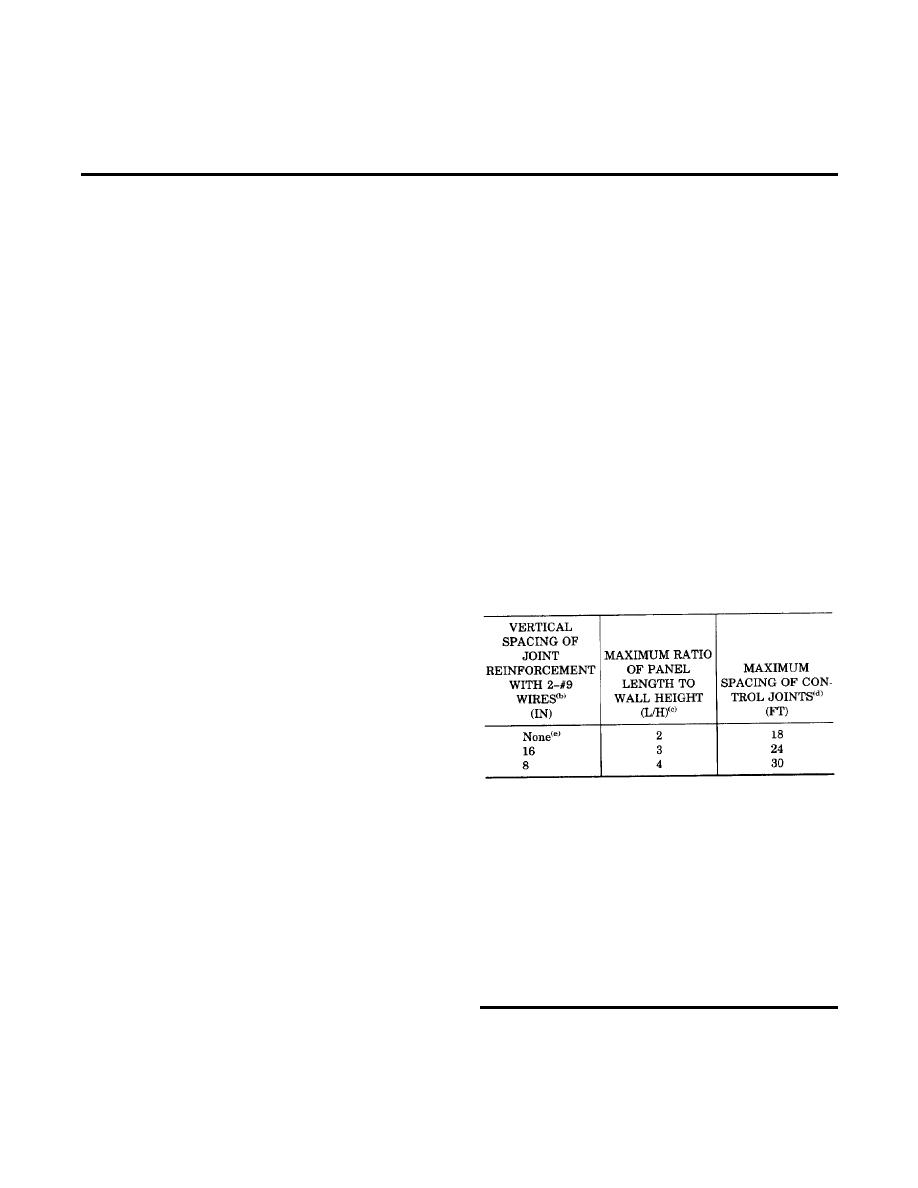
TM 5-809-3/NAVFAC DM-2.9/AFM 88-3, Chap. 3
CHAPTER 4
DESIGN FOR CRACK CONTROL
4-1. Introduction. This chapter provides criteria
to limit the shrinkage of the unit in the wall to a
and methods to control cracking in concrete and
level sufficient to control cracking. Masonry units
brick masonry walls, composite walls, and an-
delivered and stored at the site should be protected
chored veneer wythes. Normally, cracking in ma-
from rain and snow, which would increase their
sonry results from shrinkage in concrete masonry
moisture content.
b. Control joints. To control shrinkage cracking,
unit construction and expansion in brick masonry
unit construction. Uncontrolled cracking is a sig-
control joints should be placed and spaced to divide
nificant problem in the masonry industry. Cracking
walls or wythes into a series of rectangular panels.
is controlled by proper placement of joints, proper
Control joints should also be placed in areas of high
material selection, and by steel reinforcement, or a
stress concentration where cracking is most likely
combination thereof. Although the cracking of
to occur. Normal spacing and desirable locations
masonry is not normally a structural design
for control joints are noted in table 4-1. Control
consideration, the locations of joints placed in
joints should not be located at openings due to
masonry walls to control cracking can affect the
construction and performance problems and
structural performance of the wall. The crack
minimum reinforcement requirements. For struc-
control criteria contained herein is based on loca-
tural walls, the minimum reinforcement around
tions where environmental changes (temperature
openings is given in chapter 5. For non-structural
and moisture fluctuations) are large. When sup-
partitions, the minimum reinforcement around
ported by successful local practice; the designer
openings will consist of one No. 4 bar at each side
may deviate from the joint locations, material
and at the top and bottom of each opening.
selections, and reinforcement criteria contained in
Reinforcing bars will extend 24 inches beyond the
this manual. Locations and details of control joints,
edge of the opening.
bond beams, brick expansion joints, and structural
Table 4-1. Recommended control joint spacing (a)
expansion joints will be shown on the contract
drawings on both plan and elevation views.
4-2. Concrete masonry walls. Cracking of con-
crete masonry walls is generally caused by shrink-
age due to moisture loss in the units. Methods used
to control cracking in concrete masonry structures
are materials specifications to limit the drying
shrinkage potential, control joints (CJ*s) to
accommodate movement, and reinforcement to
(a)
based on moisture-controlled, type I, concrete masonry in
control crack size and location.
intermediate humidity conditions (ASTM C 90). The designer should
a. Material specifications. The type of unit to
adjust the control joint spacing for local conditions. The recommended
be used in all construction will be ASTM C 90,
spacing may be increased 6 feet in humid climates and decreased 6
moisture controlled, type I, units. Type II units,
feet in arid climates.
which have no moisture control, will not be used.
(b)
Joint reinforcement will he cold-drawn deformed wire with a
The ASTM C 90 standard provides limits on
minimum 9 gauge longitudinal wire size.
(c)
L is the horizontal distance between control joints. H is generally the
moisture content for moisture controlled units
vertical distance between structural supports.
depending on linear shrinkage potential and aver-
(d)
The spacing will be reduced approximately 50% near masonry
age annual relative humidity at the place where the
bonded corners or other similar conditions where one end of the
units will be installed. For example, in an area
masonry panel is restrained.
where the average annual relative humidity is 50 to
(e)
Not recommended for walls exposed to view where control of
75 percent and the linear shrinkage potential of the
cracking is important.
unit is 0.03 percent, the units should be delivered to
Recommended control joint locations
the site with a maximum moisture content of 40
a. At regular intervals as noted in table above.
b. At changes in wall height or thickness. (This does not include
percent. Units with a linear shrinkage potential of
at pilasters.)
0.045 to 0.065 percent, delivered to the same site,
c. Near wall intersections in "L", "T", and "U" shaped buildings
should have a maximum moisture content of 30
at approximately 50% of the spacing required above.
percent. The purpose of this part of the standard is
d. At other points of stress concentration.
4-1


 Previous Page
Previous Page
